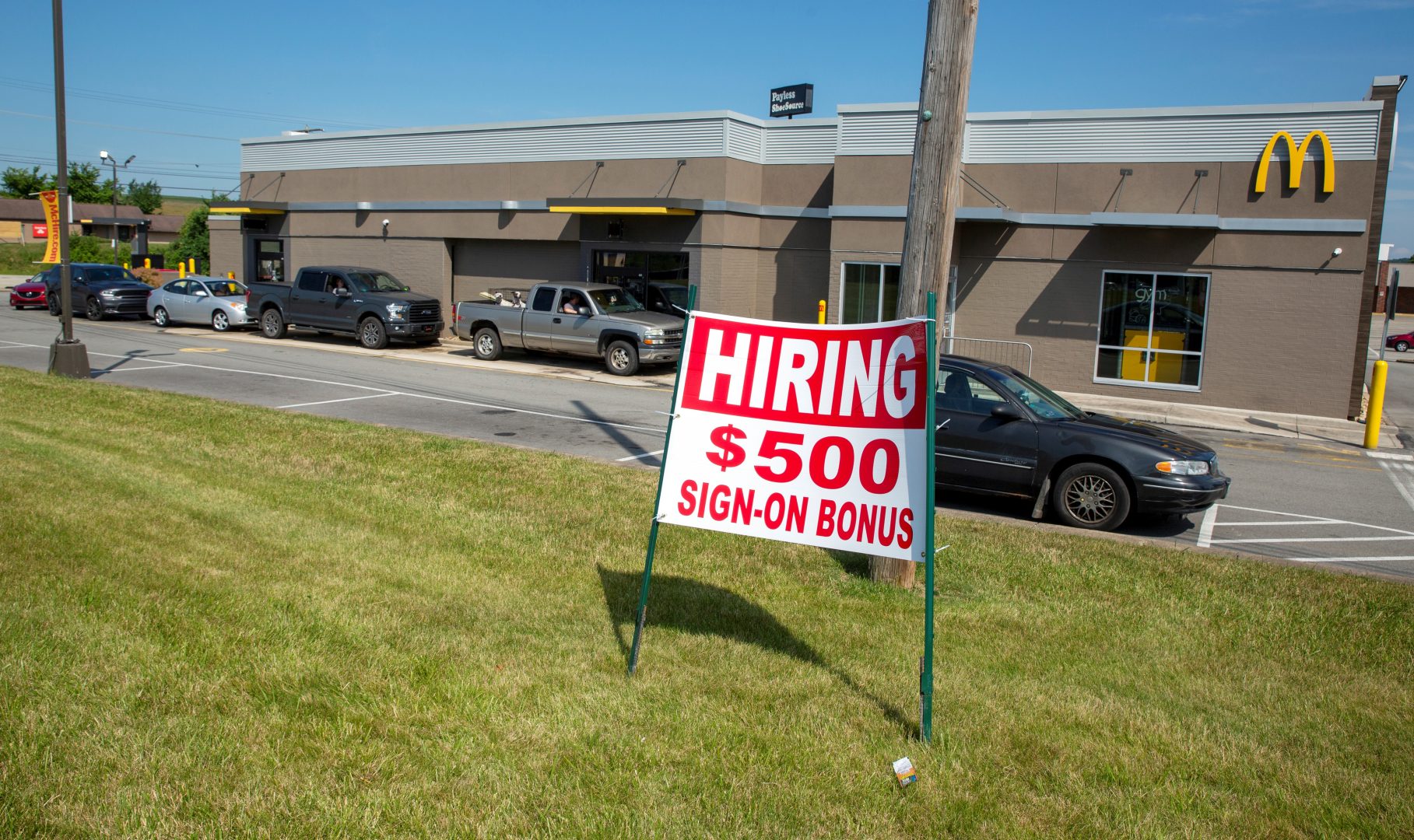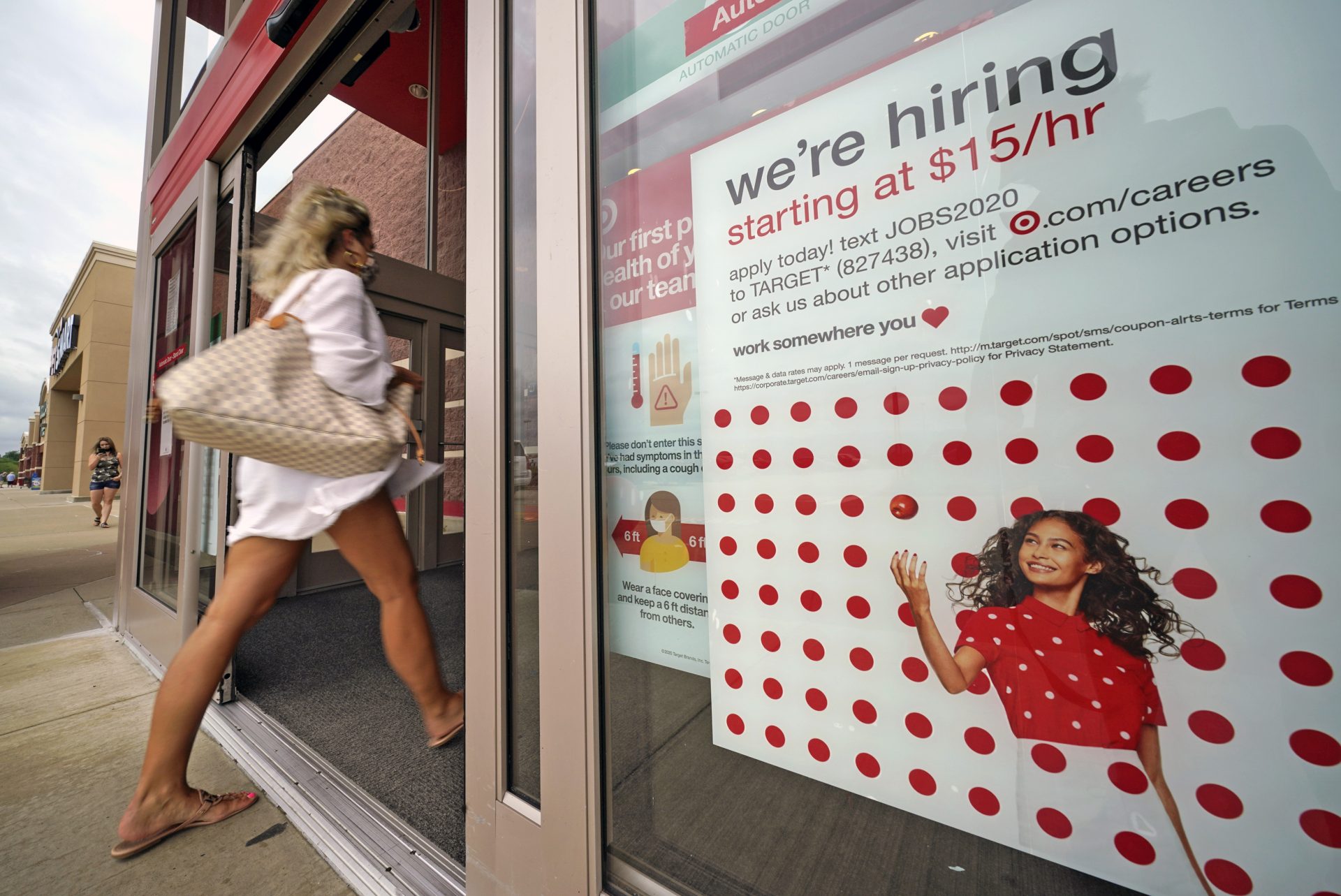
A hiring sign offering a $500 bonus is posted in front of a McDonald's fast-food restaurant in Mount Pleasant, Pennsylvania, on Sunday, June 27, 2021.
Ted Shaffrey / AP Photo

A hiring sign offering a $500 bonus is posted in front of a McDonald's fast-food restaurant in Mount Pleasant, Pennsylvania, on Sunday, June 27, 2021.
Ted Shaffrey / AP Photo

Ted Shaffrey / AP Photo
A hiring sign offering a $500 bonus is posted in front of a McDonald's fast-food restaurant in Mount Pleasant, Pennsylvania, on Sunday, June 27, 2021.
(Pittsburgh) — Americans left their jobs in record numbers in August, but new data shows that in Pennsylvania the rate of quitting trailed the rest of the country.
Some 120,000 Pennsylvanians quit their jobs in August, about 2.1% of the state’s workforce, according to data released Friday from the U.S. Department of Labor. Only the District of Columbia had a lower quit rate, although a number of states had rates similar to that of Pennsylvania. Kentucky’s was the highest in the country at 4.5%.
Nationally, the rate reached 2.9% in August, when 4.3 million U.S workers quit their jobs — the highest figures on record since tracking began in December 2000.
The pandemic has helped to prompt the exodus. There is evidence that workers are reassessing their career options. And in today’s tight labor market, they have more leverage to negotiate for higher pay and better working conditions. Quitting has become especially common in low-wage industries such as food service, hospitality and retail, where interaction with the public increases workers’ risk of exposure to the coronavirus.
But Pennsylvanians are less likely than workers in other states to be employed in these industries because education and health care account for a disproportionate share of Pennsylvania jobs, noted Laurence Ales, an economics professor at Carnegie Mellon University. Those positions tend to pay more than leisure and hospitality jobs, and they allow for greater wage growth, he said.
“The fact that we have much more concentration in these low-quit sectors naturally lowers the overall rate [of quitting in Pennsylvania],” Ales said.

Gene J. Puskar / AP Photo
In this Sept. 2, 2020, file photo, a help wanted sign hangs on the door of a Target store in Uniontown, Pa.
“This is seen as a potential good sign,” he said. But it’s possible that Pennsylvania workers who are “not necessarily satisfied” with their jobs can’t find a better replacement, he added.
“It’s more like, ‘If I quit, what happens next?’ So it may be that there are fewer other opportunities out there that one can jump to,” Ales said.
At the same time, the number of job openings in the state remains elevated, he said.
In August, 430,000 positions went unfilled in the state, with the vacancy rate hovering around 7% after reaching a 10-year high of 7.4% in May. While the rate of openings was higher in 19 other states, it stood at 6.6% for the country as a whole.
Before the pandemic, Pennsylvania’s roughly 6% unemployment rate typically would have coincided with a vacancy rate closer to 4%, Ales said.
But with today’s 7% rate, he said, “There are all these extra unfilled jobs that could be…a potential source of opportunity not being taken.”
As with its quit rate, the state’s hiring rate was the lowest in the nation in August, excluding the District of Columbia. At 3.2%, the figure did not change significantly from the previous month. Pennsylvania employers hired 181,000 people in August. During that month, the U.S. registered an overall hiring rate of 4.3%, according to the new data.
“So what we could be seeing here…is that there are aspects of the workforce that have left and are struggling to come back,” Ales said. “And issues with child care or elder care could be some obstacles that workers are finding.”
In the spring, research showed that career changes, burnout and lack of transportation also had forced southwestern Pennsylvania workers out of the labor force.
Penn State University education professor David Passmore said the new data on quitting does not reveal where workers end up going.
“It’s really important to know what happens to people who quit,” he said. “If the problem is that people are saying, ‘I quit and I’m just sitting at home, I’m going to retire, I have enough to get by, I can do something in the underground economy or whatever goes on in there,’ I think that then it’s a time to consider [offering] incentives to have people come back to work or disincentives [such as unemployment benefits] that are available to keep people from coming back to work.”
But it’s a completely different — and better — story if people are moving to new jobs, Passmore said.
“That’s what it’s all about — it’s helping to reallocate labor to where it’s needed and where people think they can work,” he said. “It may cause disruption for employers, but it may be really good for using the human capital that Pennsylvanians and Pittsburghers have in the right way.”
Passmore predicted that businesses struggling to hire will “use this as a time to re-engineer their work” to change their labor needs.
“We have great artificial intelligence and machine learning capabilities now that already are making big inroads on this. So I think we may see some of that change the picture, too,” he said.

Sometimes, your mornings are just too busy to catch the news beyond a headline or two. Don’t worry. The Morning Agenda has got your back. Each weekday morning, host Tim Lambert will keep you informed, amused, enlightened and up-to-date on what’s happening in central Pennsylvania and the rest of this great commonwealth.
The days of journalism’s one-way street of simply producing stories for the public have long been over. Now, it’s time to find better ways to interact with you and ensure we meet your high standards of what a credible media organization should be.